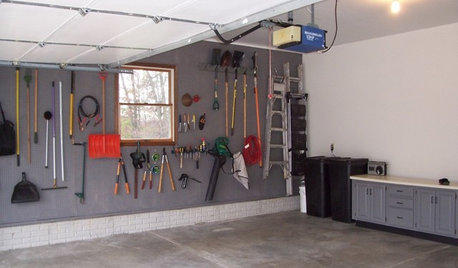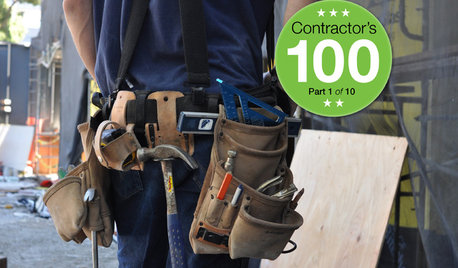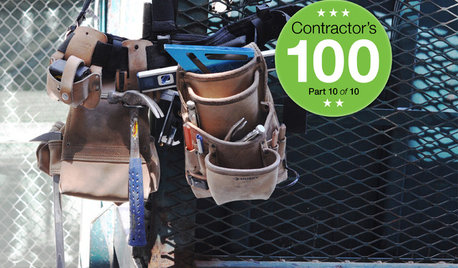Safety tips for working with live wires overhead service 120/240V
NoProjectToBig
12 years ago
Featured Answer
Sort by:Oldest
Comments (19)
petey_racer
12 years agobus_driver
12 years agoRelated Discussions
Generac cord question: 240v twistloc to (2) 120v duplex outlets
Comments (9)I give them plenty of credit for their safety practices but it only takes a tiny slip-up caused by a momentary failure to follow procedure for a tragedy to happen. While I fully understand the thought behind what you wrote, nothing contained in your post should be considered to be an excuse for not using a transfer switch. On another forum, a member was asking for for some advice about his generator. He thought it might have become damaged. WHY???? Simple. There was a storm. His power went out. He went to his panel and flipped off the main. He went to his garage and used his custom made double male end cable to connect his genny to his welder outlet in the garage so that it would backfeed his main panel. He started up the genny and left it running so his wife would have electricity while he was out. His wife was monitoring the radio and learned that the power would be turned back on in a few minutes time. She went to the garage and turned off the generator. She then went back into the house and flipped the main breaker back on in the service panel. She then realized that she had NOT uplugged the generator and started to back to the garage when suddenly the power was restored. By the time she reached the garage, smoke was now coming from the generator so she quickly unplugged it. I have yet to read an update as to what damage, if any, was suffered by the genny. Like I said... it only takes a brief second of inattention to create a dangerous situation. Had she not run back to the garage, the genny might have caught fire. Who's to say what may have transpired after that. There's a right and wrong way to do many things. This is one of those things where doing it wrong can have many disasterous results....See MoreI reduced my electric bill by $ 120.00
Comments (53)We live in Texas also. The last house we had, we ran the temp at 81 constantly and the electric bill was still $300 one August. So, we paid $15k and replaced the entire A/C, conden.. ALL of it.. heater too. The only thing we kept was the ducting. We had all the ducts re-sealed, house pressure tested and sealed (even the electrical sockets were tested for leaks). We replaced the external doors with better ones, and we had the ENTIRE attic, including over the garage, sprayed with R49, more than required. We had radiant barrier sprayed into the entire attic as well. The loan cost us like $105 a month. The electric bill dropped to about $120 a month on the hottest days and that was with us running the temp at 74-76. In the winter, we had the electric bill below $60. Best money we ever spent. R...See More120V 220V - Why?
Comments (27)A 120 V circuit is safer than a 240V one. The main advantage of 240v over 120v is that it requires only half as much current to deliver the same watts into a resistive load, therefore, the wire can be smaller. In the US, single phase residential voltage comes from a center tapped transformer. The center of the winding is the neutral while the two outer ends are the two voltages supplied to the distribution box (circuit breaker or fuse box). Both 'hot' lines measure 120v with respect to the neutral, but since these two hot lines are opposed by 180 deg, they measure 240v with respect to each other. With this system, 240 power can be supplied with lines that are at only 120v with respect to the neutral. Now for the big surprise about ac motors. For motors larger than a few horsepower, the current does not vary lineraly with the load! As the shaft load increases, the current does increase some, however, the big change is the phase angle between the voltage and current. Power delivered is voltage x current x power-factor. When the current is 90 deg to the voltage, power is zero; When the current is in phase with the voltage (0 deg), power factor is 100%. So it is possible to have considerable motor current in the wires with little power output. Fractional horsepower motors have a goodly amount of resistance compared to their reactive component and because of this have greater resistive losses. The debate between 50 and 60 hz can go on forever and from a practical sense, has existed since the dawn of electric power. 60 hz has an advantage over 50 hz in that the cross section of the iron in a transformer can be a little smaller for delivering the same power. Hysteresis losses in magnetic materials is a positive function of frequency, thereby increases with frequency. But, at the same time, the peak magnetic flux required to transmit the same power increases with decreasing frequency. Aircraft systems uses 400 hz to reduce weight. Europe tends to use 50 hz while the US and Canada uses 60 hz. Sometimes it seems that this difference is maintained to make it more difficult to apply products from one side of the ocean to the other - e.g., trade protectionism....See MoreIdentifying neutral/hot wire in 240V outlet
Comments (26)I'm not sure about the WWII copper shortage. That's just the "story" I heard. Doesn't change the safety issue. Here's an excerpt from a website that attributes the 3 wire "legalization" to the post war housing boom. A little dubious because 1947 seems to fast after WWII for a housing boom. http://www.dli.mn.gov/ccld/PDF/eli_GFCI_history.pdf Circuit grounding was one of the more hotly contested topics in the early history of electrification. In the early 1890Âs, the New York Board of Fire Underwriters had condemned the practice of grounding the neutral as a dangerous practice, especially in a 3-wire Edison (120/240 Volt) system. The Edison utility companies, on the other hand, found just cause to ground their supply systems, even as others thought the utilities were doing this to just save copper and money at the cost of an increased fire risk. The great debate continued for over a decade, but in 1903 the Code was revised to recommend that these circuits be grounded, and finally in the 1913 Code a mandatory circuit grounding requirement was included for circuits like the popular residential Edison 3-wire system. The permission for neutral grounding, the practice of using the neutral conductor as an equipment grounding conductor, was first permitted in the 1947 Code for electric ranges. At around that time many electric utilities were promoting the use of residential 240 V cooking for the post WWII housing boom, and many were even offering to install an upgraded service to older homes at no charge. However, there were no NM cables available at the time with conductors of sufficient ampacity to handle these higher amperage branch circuits. There were, though, service entrance cables of sufficient size, but they had a bare neutral conductor. This special Code permission allowed the frames of these large appliances to be grounded through the uninsulated grounded neutral conductor of the Type SE service entrance cable used to supply the branch circuit. The use of neutral grounding was also extended to electric clothes dryers in 1953. However, almost 50 years later, this special permission for neutral grounding was taken away in the 1996 Code for all but existing branch circuit installations....See MoreRon Natalie
12 years agoUser
12 years agobrickeyee
12 years agoUser
12 years agokudzu9
12 years agobus_driver
12 years agojmorrow
12 years agoNoProjectToBig
12 years agocoolvt
12 years agoRon Natalie
12 years agomypagename
8 years agoRon Natalie
8 years agoAlejandro Zavala
6 years agoVith
6 years agolast modified: 6 years agoRon Natalie
6 years agomtvhike
6 years ago
Related Stories

MORE ROOMS6 Garage Organizing Tips That Really Work
National Clean Out the Garage Day: Here's how to clear the clutter and organize what's left
Full Story
KITCHEN DESIGNA Cook’s 6 Tips for Buying Kitchen Appliances
An avid home chef answers tricky questions about choosing the right oven, stovetop, vent hood and more
Full Story
CONTRACTOR TIPSContractor Tips: 10 Home Areas That Likely Need a Pro
Safety, less cost and better aesthetics on a home improvement project may rest in the hands of an expert
Full Story
MOST POPULARContractor Tips: Top 10 Home Remodeling Don'ts
Help your home renovation go smoothly and stay on budget with this wise advice from a pro
Full Story
REMODELING GUIDESContractor's Tips: 10 Things Your Contractor Might Not Tell You
Climbing through your closets and fielding design issues galore, your contractor might stay mum. Here's what you're missing
Full Story
DIY PROJECTSHide All Those Wires in a DIY Charging Station
Keep your gadgets handy and charged with a flexible storage board you can design yourself
Full Story
BUDGETING YOUR PROJECTConstruction Contracts: What to Know About Estimates vs. Bids
Understanding how contractors bill for services can help you keep costs down and your project on track
Full Story
BATHROOM DESIGN12 Designer Tips to Make a Small Bathroom Better
Ensure your small bathroom is comfortable, not cramped, by using every inch wisely
Full Story
STORAGEClosets Too Small? 10 Tips for Finding More Wardrobe Space
With a bit of planning, you can take that tiny closet from crammed to creatively efficient
Full Story
HEALTHY HOME6 Tips From a Nearly Zero-Waste Home
Lower your trash output and increase your quality of life with these ideas from a mom who did it to the max
Full Story







Ron Natalie